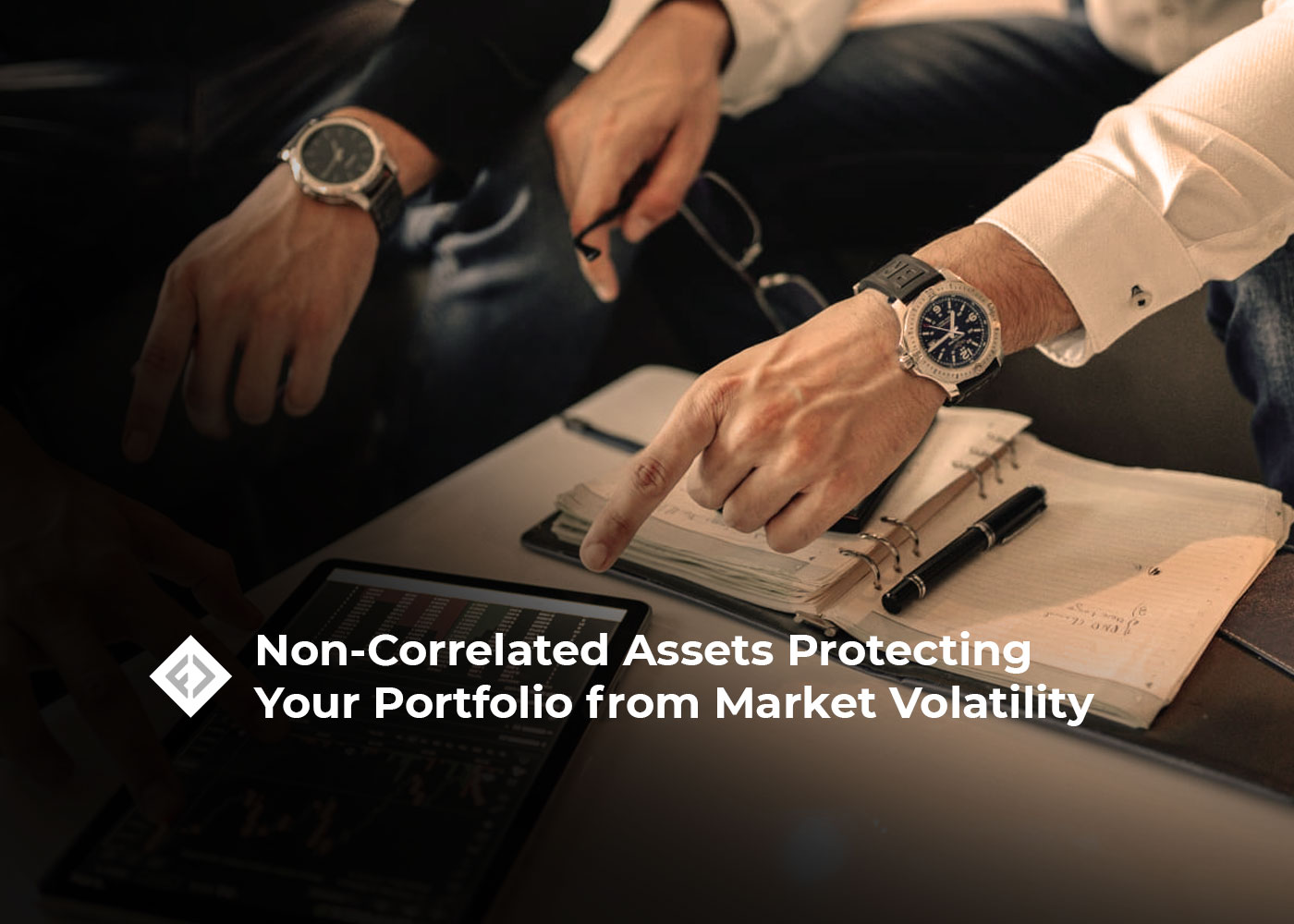Are you looking for investments to diversify and protect your portfolio from market volatility? If so, non-correlated assets should be integral to your investment strategy. Non-correlated assets do not move directly with the movements of the stock or bond markets, thereby providing a practical means of hedging against market risk. By understanding how these assets behave in different scenarios and cultivating a well-rounded portfolio that includes them, you can help ensure that no matter what changes occur in the markets, you will still have something to fall back on when times get tough. In this post, I’ll explain what non-correlated assets are, why they’re important, and provide some examples – all designed to help reduce the impact sharp economic shifts can have on your investments.
What Are Non-Correlated Assets?
Non-correlated assets are investments that often have little to no relation with the fluctuations of larger stocks or bonds. These separate investments tend to act independently from the overall stock market. They can be a great addition to any investment portfolio as they both offer diversification benefits and minimize total portfolio risk.
The correlation coefficient indicates the relationship between two assets fluctuating anywhere from -1 to 1. A perfect correlation of 1 implies that one asset moves in sync with another, while a negative correlation (-1) indicates movement in opposite directions. Assets with little-to-no connections possess coefficients nearing 0 and thus demonstrate independent behavior.
Investing in non-correlated assets can offer a diversified portfolio, from commodities like gold and oil to alternative investments such as hedge funds or venture capital. Currencies and real estate also possess distinct qualities, making them largely independent of broader market trends. By diversifying your holdings into these non-correlated assets, you can capitalize on the potential for substantial returns with minimized risk exposure.
In comparison, assets with a powerful correlation to the broader market, for example, stocks or bonds, can be significantly influenced by market changes and may result in massive losses during times of financial volatility. Consequently, diversifying an investment portfolio with non-correlated assets can shield against these risks and potentially augment overall returns.
Why Diversification Is Key?
Diversification is paramount to minimize the risk of losing your portfolio’s value. Investing in different asset classes and markets help to reduce the effects of market volatility on an investment. When you spread out your investments, you are less susceptible to experiencing a significant loss from any one particular asset or market that might be affected by adverse conditions.
Creating a portfolio by combining various assets can result in dissimilar returns. If one asset experiences losses, other investments may perform well and cushion the impact on the entire portfolio. By diversifying across different asset classes, they move separately from each other, and thus investors can protect their capital from unforeseen market shifts.
Diversifying your investments can mitigate risk and provide the potential for greater returns over time. Investing in different asset classes with various risk and return profiles allows you to access a much wider range of investment opportunities that could help increase profits compared to if you were just invested in one type of asset class.
Nevertheless, it’s important to remember that diversifying your investments does not guarantee a profit or protect against all losses. It is still possible for the assets in a diverse portfolio to decline together during an economic downturn or financial crisis. Thus, investors must regularly assess and adjust their portfolios to maintain appropriate diversity based on investment objectives, risk-taking ability, and market conditions.

Types of Non-Correlated Assets:
Diversifying your investment portfolio with non-correlated assets can help guard against market turbulence and generate additional returns. Here are some of the most sought-after forms of asset diversification:
Commodities:
Regarding safeguarding against inflation and currency instability, commodities such as gold, silver, oil, and agricultural products can be invaluable sources of protection. Not only do they serve as a buffer during periods of economic volatility, but they also provide a reliable store of value.
Real Estate:
Real estate offers a priceless opportunity to diversify any portfolio due to its low correlation with other asset classes like stocks and bonds. You can look into REITs (Real Estate Investment Trusts), rental properties, or even invest directly in commercial or residential buildings to gain access. Investing in real estate can truly pay off!
Currencies:
Exploring foreign currency investments can greatly diversify your portfolio and benefit from different economic and political forces. However, it’s essential that you have an in-depth understanding of the markets as well as potential risks before engaging in any trading strategies; this type of activity is often highly intricate and risky.
Alternative Investments:
Alternative investments, including hedge funds, private equity, and venture capital, showcase investment opportunities that may not correlate with traditional asset classes. While these options can bring in generous returns, they also come burdened by hefty fees and risks. Furthermore, most of these investments are only available to accredited investors.
Collectibles:
Collectibles, for example, art, antiques, and rare coins, can serve as non-correlated investments since they are not explicitly dependent on the stock or bond markets. Nonetheless, investing in collectibles necessitates expert knowledge and encompasses potential risks such as valuation changes and liquidity issues.
As investors, it is essential to understand the risks and benefits of each non-correlated asset before investing. Assessing your investment objectives, risk tolerance level, and portfolio diversity approach can help you determine if adding a new asset class to your portfolio makes sense for you.
Risks of Non-Correlated Assets:
Non-correlated assets can certainly provide a degree of diversification, thereby shielding your portfolio from market volatility. That being said, it’s essential to remember that these types of investments come with their own risks. Here are some main ones:
Volatility:
Investing in non-correlated assets like commodities, real estate, and alternative investments can be extremely unpredictable, with the potential for large price shifts. This enormous volatility makes it difficult to forecast future returns, which could lead to huge losses.
Lack of liquidity:
Private equity, venture capital, and collectibles are some examples of non-correlated assets that can be hard to liquidate. A scarcity in liquidity can make it difficult to exit an investment without incurring losses if market conditions are poor at the time.
Concentration risk:
Concentration risk can prove costly, as it exposes a large proportion of your portfolio to the performance of one non-correlated asset. If this single asset performs poorly, you are in danger of incurring heavy losses – so be sure to spread out investments across multiple assets!
Complexity:
Plunging into the world of non-correlated assets, such as hedge funds and private equity, can be daunting. This difficulty in understanding these investments means investors are not fully aware of the associated risks, leading to potential losses that could have been avoided if they had taken more time to comprehend their investment decisions.
Regulatory risk:
Investing in non-correlating assets, such as cryptocurrencies and other alternative investments, can be risky. Regulatory modifications could have an unpredictable effect on their value and carry the potential for financial loss. Unexpected shifts in government policies or regulations may cause drastic price variations without warning.
As an investor, it is paramount to assess the possible risks of non-correlated assets before investing and guarantee that your portfolio has a reasonable balance between risk and return for each asset. When approaching investments in such unseen markets, caution should always be practiced with a profound comprehension of the feasible threats associated.
Incorporating Non-Correlated Assets Into Your Portfolio
When you include non-correlated assets in your portfolio, it can help mitigate risk and offer diversification advantages. Here are some steps to bear in mind for incorporating these kinds of assets:
- Determine your investment goals and risk tolerance: Before bringing any additional asset class into your portfolio, ensure that you know your investment goals and risk comfort level. Ask yourself how much volatility you can handle and what is the ultimate goal for these investments. By analyzing this data beforehand, you can make sounder decisions when making fiscal choices.
- Identify potential non-correlated assets: Thoroughly investigate various non-correlated assets and discern which ones agree with your investment objectives and risk tolerance. A few of the more widespread examples are commodities, real estate, currencies, alternative investments, and collectibles.
- Evaluate the risks and benefits: Before investing, take the time to gauge both the benefits and risks of each non-correlated asset. Consider all volatility, liquidity, regulatory aspects, and any potential rewards.
- Determine how much to invest: Consider how much of your portfolio should go towards non-correlated assets. It’s recommended to keep a portion low, so you can enjoy the diversification benefits without taking on too much risk.
- Rebalance your portfolio: To maintain the ideal diversification of your portfolio, it is essential to consistently observe and rebalance its components once non-correlated assets have been incorporated. Rebalancing entails readjusting your investments to remain consistent with your objectives as an investor and how much risk you are willing to take.
- Consider working with a financial advisor: If you are just starting out with non-correlated investments or feel intimidated by the prospect of incorporating them into your wealth management strategy, it may be beneficial to hire a financial advisor. They can assist in making informed decisions and ensure you understand any possible risks and rewards associated with different types of these assets.
To mitigate overall risk and capitalize on advantageous diversification, ensure you include a range of non-correlated assets in your portfolio. Nonetheless, take the time to assess each asset’s potential risks and rewards comprehensively before adding them to your investment mix. Moreover, it is prudent that you regularly reassess your investments using appropriate rebalancing and continually surveying all portfolios.
Let’s Wrap It Up:
In conclusion, non-correlated assets provide a risk-averse approach to stock market investment. When constructing a portfolio of these types of investments, investors can be more confident that they are protecting their capital from wide market fluctuations and economic downturns. Non-correlated assets also offer attractive returns in some cases, making them an ideal choice for the wise investor looking to minimize the risks of investing while still earning attractive returns. Before making any decisions, it is important to understand each asset class one intends to invest in and ensure the appropriate amount of diversification exists in each type of investment. Finally, it is worth emphasizing that the right balance between risk and reward should be considered before jumping into an investment opportunity, as successful investing involves taking calculated risks based on sound research – so be sure to do your own research first!











